4.1.1 Evidence to support the theory of evolution
advertisement
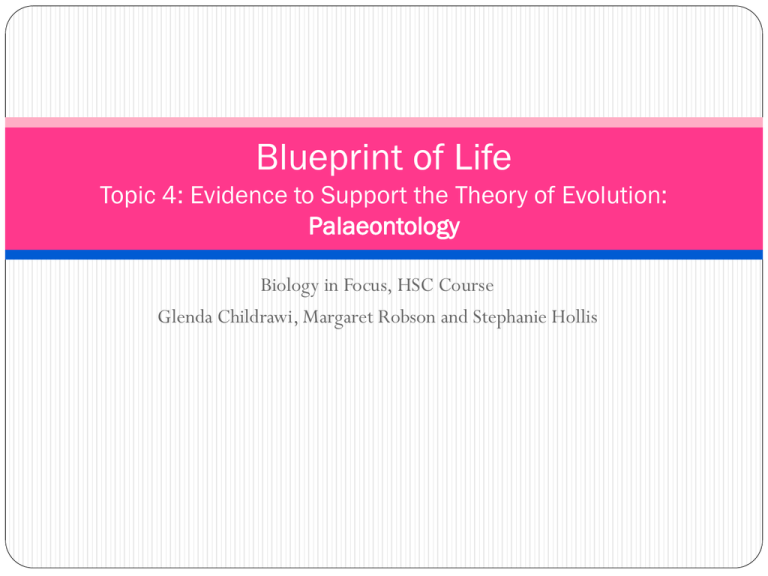
Blueprint of Life Topic 4: Evidence to Support the Theory of Evolution: Palaeontology Biology in Focus, HSC Course Glenda Childrawi, Margaret Robson and Stephanie Hollis DOT POINT(s) describe, using specific examples, how the theory of evolution is supported by the following areas of study: palaeontology, including fossils that have been considered as transitional forms (today) biogeography comparative embryology comparative anatomy biochemistry Introduction Darwin’s theory of evolution by natural selection is supported by a large amount of evidence, gathered over more than a century. Since macro-evolution takes place over millions of years, it is impossible to directly test it by experimentation or observation within a lifetime or even over many generations. www.famousdyslexicpeople.com Introduction Therefore evidence must be gathered to support the theory of evolution—the theory cannot be proved. To validate this theory, scientists have made predictions and then tested them—so far, many predictions have held true and so the theory is considered ‘valid’, but all strands of evidence have their limitations. bostinno.com Introduction Over the next few lessons we are going to look at evidence that has been found to support the five strands of the theory, predictions that have held true and the limitations of each strand of evidence. These are straight from the DOT Point: palaeontology, including fossils that have been considered as transitional forms biogeography comparative embryology comparative anatomy biochemistry dsc.discovery.com Palaeontology Palaeontology is the study of fossils. Fossils provide direct evidence of the existence of an organism in the past. Fossils may be mineralised remains in rock or the actual remains of the organism preserved in rock, ice, amber, tar, peat or volcanic ash. www.flickr.com Palaeontology Even before Darwin’s proposal, scholars recognised that the idea of change in organisms over time was supported by evidence in undisturbed rock formations: the sequence in which fossils are laid down in rock reflects the order in which they were formed, with the oldest fossils in the bottom-most layers of the rock and the more modern fossils in the rock layers closer to the top. Based on this finding, predictions could be made and tested in attempting to validate the theory of evolution by natural selection. world.edu Palaeontology One prediction based on the fossil record is that, the sequence of fossils found in rock formations should reflect the order of changes observed in organisms that originated from a common ancestor. evolution.berkeley.edu Palaeontology Another prediction was made by Darwin himself: that the fossil record should yield intermediate/ transitional forms— organisms that show transitions from one group to another (‘missing links’ between groups). For example, if amphibians have evolved from fish, one would expect to find fossils of organisms that show features of both their fish ancestors and the amphibian forms to which they would eventually give rise. sciencenotes.wordpress.com Palaeontology We have evidence of fossils in undisturbed rock formations throughout the world have shown a similar sequence, supporting the idea that living things arose in a particular sequence or order. sarcozona.org Palaeontology Today, Darwin’s prediction of intermediate forms is supported by evidence in the form of thousands of known fossils that appear to have features common to two known groups, suggesting that a transition occurred in the past from one group to another. These fossils, termed transitional forms, represent successive change in organisms over a long period of time. evolution.berkeley.edu - Examples of Transitional Forms Fish to amphibians: fossils of lobe-finned fish (Crossopterygii) (sometimes termed ‘fleshy-finned’ fish) show that these fish had bones in their paired fins that may have allowed them to drag themselves over land, from one mud pond to the next, when the environment changed and land was drying out. These fins are thought to represent the ancestral limbs of terrestrial vertebrates. en.wikipedia.org Examples of Transitional Forms Crossopterygii were all thought to be extinct, but some living examples of these lobe-finned fish have been found fairly recently—the first, in 1938, was a coelacanth found off the South African east coast. This ‘living fossil’ caused great excitement in the research world. thelife-animal.blogspot.com Examples of Transitional Forms Other living fish that may share a common ancestor with amphibians are the lung fish. Lobe-finned fish were originally thought to be direct ancestors of amphibians, but more recent research shows that amphibians and lung fish (which still have living forms in Australia today) seem to share a direct common ancestor. www.redorbit.com Examples of Transitional Forms Reptiles to birds: The most ancient recognised fossil bird, found in rocks dated 150 million years old, is Archaeopteryx, a reptile-like bird. talkrational.org Examples of Transitional Forms Archaeopteryx has a mixture of reptilian and birdlike characteristics, having clear impressions in limestone of feathers on its forelimbs and on its tail, as well as a ‘wishbone’ (fused clavicles called a furcula) extending into a keel bone for attachment of flight muscles, typical of birds.Yet it also displays features typical of a reptile, such as teeth (in its beak), bones in its tail and claws on three digits of its forelimbs (wings). world.edu Examples of Transitional Forms Terrestrial mammals to marine mammals: whales are aquatic mammals, not fish. They are thought to have evolved from a terrestrial mammal ancestor—a hypothetical four-footed, hoofed creature. By evolution, this creature is believed to have changed to a mammal with limbs similar to a modern sea lion. biologos.org Examples of Transitional Forms Fossilised remains of two transitional forms, Ambulocetus and Rhodocetus have been found showing hind limbs which became smaller, until they were eventually lost completely, resulting in whales which have no hind limbs, but do have remnants of a skeletal pelvis. www.tumblr.com Examples of Transitional Forms Early horses to modern-day horses: fossils of early horses show small animals with four toes and a narrow cheek span, compared with modern day horses which have only one toe and a large cheek span. Fossilised remains of transitional forms of horses show three toes with an intermediate cheek span. darwiniana.org Examples of Transitional Forms Other commonly studied examples of fossilised transitional forms include Therapsida (mammal-like reptiles) and seed ferns in the plant kingdom (a seed fern is an intermediate between ferns which today reproduce by means of spores, and the more advanced conifers and flowering plants which are seed-bearing). www.locolobo.org Limitations of Palaeontology The main limitation of the fossil record is that it is incomplete and so it is not a random sample of past life: There is a bias towards organisms whose body parts or environment makes them better suited to becoming fossilised, e.g. those with hard body parts and those that live in aquatic environments. There is a lack of fossils representing the majority of early or soft-bodied organisms. Limitations of Palaeontology There is an unequal representation of transitional organisms; e.g. certain organisms such as the horse have well-represented lines of descent, whereas evolutionary transitions of many other organisms are not represented in the fossil record at all. www.123rf.com Conclusion Fossils give us consistent evidence of past life forms that reflect the evolutionary transitions to modern forms of living organisms. But since fossil evidence has its limitations, it is necessary to examine additional strands of evidence to further validate the theory of evolution. We’ll investigate some additional strands next lesson. en.wikipedia.org Activity -Students to complete DOT Points 1.4.1-1.4.3



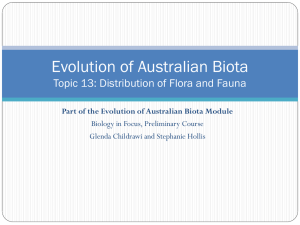

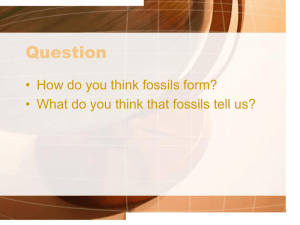
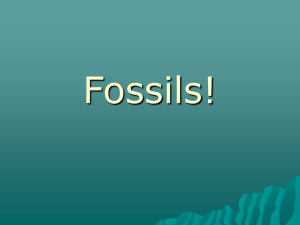
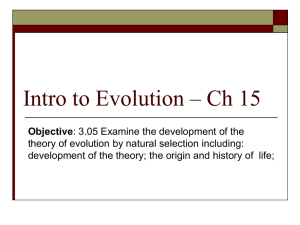
![8th_Grade_Science_EOG_Review[1]](http://s2.studylib.net/store/data/005499036_1-540adc8cddff78258f912f25485a62a4-300x300.png)
